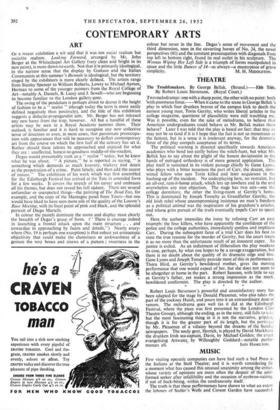CONTEMPORARY ARTS
ART
OF a recent exhibition a wit said that it was not social realism but socialite realism. Looking Forward, arranged by Mr. John Berger at the Whitechapel Art Gallery (very clean and bright in its new paint), is more down-to-earth. Not that iris primarily ideological, in the narrow sense that the display by Guttuso and the Italian Communists at this summer's Biennale is ideological, but the territory ringed by the exhibitors is more clearly defined. The artists range from Stanley Spencer to William Roberts, Lowry to Michael Ayrton, Herman to some of the younger painters from the Royal College of Art—notably A. Daniels, B. Lacey and J. Sewell—who are beginning to become familiar to the London gallery-goer.
The swing of the pendulum is perhaps about to decree it the height of fashion to be a " realist " (though today the term is more easily defined negatively than positively), and the title of this exhibition suggests a didactic-propagandist aim. Mr. Berger has not released any new hares from the trap, however. All but a handful of these artists may be seen in a Royal Academy summer show. Their outlook is familiar and it is hard to recognise any new collective sense of direction or even, in most cases, that passionate preoccupa- tion with appearances that will be necessary to deflect contemporary art from the course on which the first half of the century has set it. Rather should these talents be approached and enjoyed for what they are : unaffected, honest-to-goodness middle-of-the-roaders. Degas would presumably rank as a " realist " today, but he knew what he was about. " A picture," he is reported as saying, " is something which demands as much knavery, trickery and deceit as the perpetration of a crime. Paint falsely, and then add the accent of nature." The exhibition of his work which was first assembled for the Edinburgh Festival has arrived at the Tate in amended form for a few weeks. It covers the stretch of his career and embraces all his themes, but does not reveal his full stnture. There are several unfamiliar or unexpected things—the painting of The Dead Fox, for example, and the copy of the Mantegna panel from Tours—but one would have liked to have seen more oils of the quality of the Louvre's Race Meeting, with its focal point of pink and black, and the splendid portrait of Diego Martelli.
In colour the pastels dominate the room and display most clearly the breadth of Degas's grasp of form. (" There is courage indeed in launching a frontal attack upon the main structure . . . and cowardice in approaching by facets and details.") Nearly every- where (No. 19 is perhaps one exception) is that robust yet aristocratic objectivity that could make the clumsiness or awkwardness of a gesture the very bones and sinews of a picture ; sweetness in the colour but never in the line. Degas's sense of movement and the third dimension, seen in the cavorting horses of No. 24, the novel perspectives (41) and the constant preoccupation with diagonals from top left to bottom right, found its real outlet in his sculpture. The Woman Wiping Her Left Side is a triumph of forms manipulated in space and the little Dancer of 14—as always—a masterpiece of grave


































 Previous page
Previous page